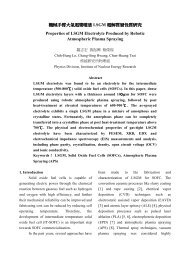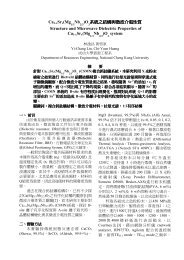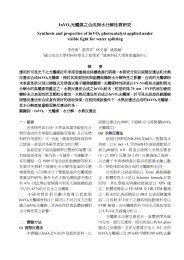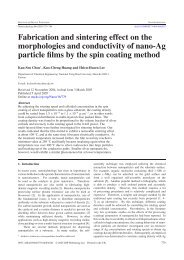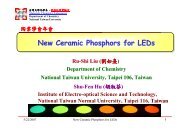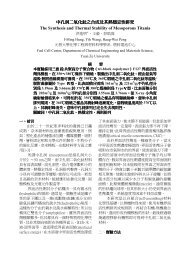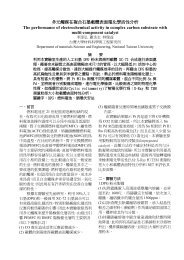core shell sorbent.pdf
core shell sorbent.pdf
core shell sorbent.pdf
You also want an ePaper? Increase the reach of your titles
YUMPU automatically turns print PDFs into web optimized ePapers that Google loves.
A novel method to make regenerable <strong>core</strong>-<strong>shell</strong> calcium-based <strong>sorbent</strong>s<br />
Abstract<br />
F.J. Liu a, *, K.S. Chou b , Y.K. Huang b<br />
a Department of Chemical Engineering, National United University, 1 Lien Da, Kung-Ching Li, Miao-Li 36003, Taiwan, ROC<br />
b Department of Chemical Engineering, National Tsing Hua University, Hsinchu 30013, Taiwan, ROC<br />
Received 16 August 2004; revised 24 May 2005; accepted 30 May 2005<br />
Available online 19 September 2005<br />
A <strong>sorbent</strong> having a calcium oxide <strong>core</strong> and a clay <strong>shell</strong> was prepared and shown to be capable of reusable applications in absorption and<br />
desorption processes for carbon dioxide. The novelty of this <strong>sorbent</strong> is that only calcium carbonate and clay are used for its preparation with<br />
water as a binder. A two-step granulation procedure is used to get the <strong>core</strong> and then another step to coat the <strong>shell</strong> layer with the clay powder. A<br />
repeated wet-and-dry procedure probably makes the <strong>core</strong> porous yet strong enough to serve as a <strong>sorbent</strong>. The pellet is then calcined at<br />
1200 8C for 2 h to reach its final structure. The <strong>core</strong>-<strong>shell</strong> pellets have an overall diameter of 4.4 mm with average <strong>shell</strong> thickness of 0.45 mm,<br />
crush load of 35 N and attrition index of 0.035 wt%/h. These results indicate that the pellets will probably be capable of withstanding the<br />
stress in future applications. Carbon dioxide absorption at or below 300 8C showed a maximum weight gain of 38% for our pellets. Finally,<br />
desorption in nitrogen at 800 8C can restore the pellet to its original state and hence it is ready for re-use as a <strong>sorbent</strong>.<br />
q 2005 Elsevier Ltd. All rights reserved.<br />
Keywords: Core-<strong>shell</strong>; Calcium carbonate; Sorbent<br />
1. Introduction<br />
There are many occasions, such as in the case of coalfired<br />
power plants utilizing gas turbines, where both<br />
particulates and gaseous pollutants need to be removed<br />
from the hot gas. One proposal for doing this is to use a<br />
moving granular bed filter (Henriquez and Macias-Machin,<br />
1997; Hsiau et al., 1999). The success of this process<br />
depends on the quality of the granular <strong>sorbent</strong>. Some of the<br />
desired characteristics of such a <strong>sorbent</strong> include at least:<br />
sufficient crushing strength to maintain integrity and<br />
resistance to attrition during operation; capable of operating<br />
at high temperatures; capable of reacting with H2S or other<br />
corrosive gases and also regenerable after use.<br />
When the purpose is limited to the removal of particles,<br />
i.e. acting only as a filter, various materials can be used to<br />
make the granules. However, if gaseous pollutants must also<br />
be removed, the materials to choose from are greatly<br />
limited. For H2S removal, calcined limestone is usually used<br />
(van der Ham et al., 1996; Akiti et al., 2002a, b; Hasler et al.,<br />
* Corresponding author. Fax: C886 37 332397.<br />
E-mail address: liu@nuu.edu.tw (F.J. Liu).<br />
0301-4797/$ - see front matter q 2005 Elsevier Ltd. All rights reserved.<br />
doi:10.1016/j.jenvman.2005.05.013<br />
Journal of Environmental Management 79 (2006) 51–56<br />
www.elsevier.com/locate/jenvman<br />
2003). Here, CaO is first converted to CaS during<br />
absorption. Then, for its regeneration, calcium sulfide can<br />
be oxidized to CaSO4 and then be reduced with CO or H2<br />
back to CaO for re-use. Wheelock and colleagues (Akiti<br />
et al., 2002a, b; Hasler et al., 2003) have studied the various<br />
compositions to prepare this <strong>sorbent</strong> with the desired<br />
characteristics. They propose a <strong>core</strong>-<strong>shell</strong> structured pellet<br />
for this purpose. They tried to use either limestone or plaster<br />
of Paris to make the <strong>core</strong>. In the first case calcium aluminate<br />
cement was used as a binder to hold the limestone particle<br />
together. As for the <strong>shell</strong>, limestone particles mixed with<br />
either alumina or calcium aluminate cement were used. The<br />
basic idea was that the <strong>shell</strong> should be porous but strong<br />
enough to offer some protection for the <strong>core</strong> material.<br />
Integrated coal gasification combined cycle (IGCC)<br />
power generation systems hold great promise for producing<br />
electric power efficiently and economically. Limestone is<br />
extensively used in the in situ removal of acid gas species<br />
such as SO2, CO2 from pulverized and fluidized-bed coal<br />
combustors and H2S from advanced combined-cycle<br />
gasification systems. Usually, the SO 2 removal process<br />
takes place at higher temperatures and is more dangerous.<br />
Hence, in the preliminary experimental stage, only the CO 2<br />
removal process was investigated. In this article, an<br />
alternative method is proposed for making the <strong>core</strong>-<strong>shell</strong>
52<br />
pellets using only limestone and clay particles. The results<br />
show that it possesses all the required characteristics to<br />
serve as a <strong>sorbent</strong> in moving bed operations.<br />
2. Experimental<br />
2.1. Materials and methods<br />
Calcium carbonate (densityZ2.7 g/cm 3 , purityZ<br />
99.3 wt%, B201, Zu-hsin, Taiwan) and clay (densityZ<br />
2.7 g/cm 3 , hydrated aluminum silicate, 37.8 wt% Al2O3,<br />
62.1 wt% SiO 2, No. 26, Tao-yi, Taiwan) were the only two<br />
materials used in this work. The purity of the calcium<br />
carbonate was 99.3%, and it had a BET surface area of<br />
5.44 m 2 /g, or an equivalent particle size of around 0.408 mm<br />
(for spherical particles, dZ6/(rs), d is the equivalent<br />
particle size, ris the density, and s is the BET surface<br />
area). The clay on the other hand had a BET surface area of<br />
20.74 m 2 /g, or an equivalent size of 0.115 mm. The method<br />
used for estimating the equivalent diameter of the small<br />
particles is subject to two major errors. One error is due to<br />
the assumption that the particles were spherical. The second<br />
error arises from using the BET surface area, which<br />
measures both the external particle surface area and the<br />
surface area of micropores to calculate the equivalent<br />
diameter. Only the external surface area should be used for<br />
calculating the equivalent particle diameter.<br />
To obtain <strong>core</strong>-<strong>shell</strong> structured pellets, Akiti et al. (Akiti<br />
et al., 2002a, b; Hasler et al., 2003) tried to use either plaster<br />
of Paris or limestone with calcium aluminate cement as a<br />
binding agent. Yet, as found in this study, calcium carbonate<br />
<strong>core</strong> pellets can be made by simply using water as a binder.<br />
Pelletization was carried out in a planetary ball mill<br />
(centrifugal ball mill pulverisette 6, Fritsch, Germany),<br />
which had been modified by replacing the grinding bowl<br />
with a 1000 ml polypropylene beaker without the cover. The<br />
beaker is mounted on a horizontal rotating disc with the<br />
longitudinal axis of the beaker at right angles to the disc and<br />
off center. Consequently, when the disc is rotated, the<br />
beaker operates in a planetary motion. Forty grams of<br />
CaCO3 powder was placed in a beaker on a planetary ball<br />
mill with a rotating speed of 150 rpm, 5 ml de-ionized water<br />
was sprayed intermittently into the beaker to ball up the<br />
calcium carbonate particles. At the same time, a glass rod<br />
was used to break up any large granules that might be<br />
formed due to the non-uniform distribution of water. After<br />
about 10 min, a sieve was used to collect pellets within the<br />
size range of 1.41–2.36 mm.<br />
These pellets were then put back into the beaker to which<br />
another 20 g of CaCO3 powder had already been added, and<br />
the above procedure was continued to finally get pellets of<br />
two size ranges: 4.0–4.76 mm (labeled as CS2-L) and 2.36–<br />
4.0 mm (as CS2-S). The pellets were then sprayed with<br />
small amounts of water (merely making them moist) and<br />
then dried in an oven at 50 8C for 1 h. This wetting<br />
F.J. Liu et al. / Journal of Environmental Management 79 (2006) 51–56<br />
and drying procedure was repeated three times to make the<br />
pellets strong enough for further processing steps. During<br />
this procedure, the green body of the <strong>core</strong> pellets retained its<br />
integrity and appeared more dense having sufficient<br />
strength. After obtaining the CaCO3 <strong>core</strong> pellets, they<br />
were then placed into clay powder (5 g) to form <strong>shell</strong>s using<br />
the same procedure. These <strong>core</strong>-<strong>shell</strong> pellets were then<br />
heated at a rate of 10 8C/min to 1200 8C and held there for<br />
2 h to obtain our <strong>sorbent</strong> having a porous CaO <strong>core</strong> and clay<br />
<strong>shell</strong>.<br />
2.2. Properties and tests<br />
The <strong>sorbent</strong>s were examined for their mechanical<br />
strength against compression and attrition. The compressive<br />
strength of the pellets was determined by measuring the<br />
force required to fracture a single pellet between two plates<br />
of a universal testing instrument (Shimadzu AGS-2000G)<br />
with the upper plate lowered at a rate of 2 mm/min. About<br />
15 pellets from each sample were tested. For comparison,<br />
the strength of some CaO <strong>core</strong>s (i.e. without the clay <strong>shell</strong>)<br />
of several different sizes was also measured. Several<br />
attrition test methods are available to measure the attrition<br />
tendency of fluidized solids or moving solids in a drum. In<br />
this work, the Peter-Spencer method was adopted (Deng and<br />
Lin, 1997). The testing equipment consisted of a variable<br />
speed drive motor and a stainless steel tube (315 mm long,<br />
10 mm ID) mounted on the drive shaft at a right angle to the<br />
shaft and at a point which was 80 mm from one end of the<br />
tube. The ends of the tube were closed so that as the tube<br />
revolved the pellets being tested would flow back and forth<br />
from one end of the tube to the other end. The tube was<br />
rotated about an axis normal to the length with a controlled<br />
speed ranging from 20 to 200 rpm. Briefly, about 5 g of<br />
pellets were placed in a stainless steel tube and the tube was<br />
rotated at 60 rpm for 24 h before measuring the weight<br />
changes caused by attrition. At the end of the attrition test<br />
the material had to be screened (Tyler standard screen mesh<br />
#10) to separate the fines, which were generated from the<br />
remaining pellets. The weight loss percentage rate (wt%/h)<br />
calculated by the following equation was used as attrition<br />
index (Deng and Lin, 1997):<br />
Attrition index Z ðinitial weight<br />
Kremaining weightÞ=initial weight=time<br />
!100%:<br />
To gain some knowledge about the porosity and pore size<br />
distribution of these <strong>sorbent</strong>s, a mercury porosimeter (PMI<br />
60 KA2) was used.<br />
The absorption characteristics of a <strong>sorbent</strong> pellet was<br />
determined by employing a thermogravimetric analyzer<br />
(TGA, SSC 5000, Seiko, Japan) to determine the weight<br />
gain as a function of time at temperatures ranging from 50 to<br />
300 8C under flowing gas of 95 vol% N2 and 5 vol% CO2.
However, before each absorption run, the pellet was first<br />
heated under flowing nitrogen to 800 8C to remove any CO2<br />
or moisture previously picked up by the pellet from the<br />
atmosphere. It was then cooled down to the desired<br />
temperature and held for 5 min before switching to the<br />
mixture gas of N 2 and CO 2 for absorption experiments. In<br />
order to demonstrate the ability for reuse of these pellets, we<br />
would heat the pellet up to 800 8C again in nitrogen after<br />
absorption to remove absorbed CO2 and then cool it down to<br />
300 8C for a repeated absorption experiment. It was repeated<br />
three times.<br />
3. Results and discussion<br />
3.1. Basic properties<br />
Shown in Fig. 1 are the SEM pictures of the original<br />
CaCO 3 powder before and after having been calcinated<br />
at 1200 8C for 2 h. Quite different morphology was<br />
observed between them. Next, in Fig. 2 a photograph is<br />
shown both of the pellet made in this work and a cut-off<br />
view of the <strong>core</strong>-<strong>shell</strong> structure. The thickness of the<br />
<strong>shell</strong> was about 0.45 mm. Due to different shrinkage of<br />
the <strong>core</strong> and <strong>shell</strong> materials, there was also some space<br />
between the <strong>core</strong> and <strong>shell</strong> after calcination, which is<br />
F.J. Liu et al. / Journal of Environmental Management 79 (2006) 51–56 53<br />
Fig. 1. SEM pictures of (a) the original CaCO 3 powder; and (b) after 1200 8C calcinations.<br />
very beneficial to the absorption since there is always a<br />
volume increase accompanied with either CO2 or H2S<br />
absorption. Simple calculation indicates that when CaO<br />
changes into CaCO3, the volume increases by about<br />
117%. The pellet would crumble if there were no room<br />
for such an expansion.<br />
Next shown in Fig. 3 are the compressive strengths (in<br />
terms of crush load) of several different pellets made in this<br />
work. On the left, for comparison purposes, are the crushing<br />
loads of the CaO <strong>core</strong>s of three different sizes, ranging from<br />
1.41 to 4.0 mm. On the right side are the corresponding<br />
values of some CaO <strong>core</strong>-clay <strong>shell</strong> pellets. The pellets used<br />
here were all tested after calcination at 1200 8C for 2 hours.<br />
The increase in strength due to the clay <strong>shell</strong> is very<br />
obvious. Also noticeable is that a large pellet often<br />
possesses slightly higher strength than a small one. In this<br />
figure, CS1 refers to the pellets made from one pelletizing<br />
step, while CS2 refers to those made from two pelletizing<br />
steps. The overall diameters of CS1 and CS2-L are 4.4 mm<br />
and CS2-S is 3.2 mm. The average <strong>shell</strong> thickness for these<br />
pellets is about 0.45 mm. The strengths of various pellets are<br />
not very much different. However, the CS1 pellets cracked<br />
after the CO2 adsorption experiments. It seems that the CaO<br />
<strong>core</strong> in the CS2 pellets may contain more porosity due to the<br />
two steps of the pelletizing procedure. Porosity inside the<br />
CaO <strong>core</strong> as well as the space between the <strong>core</strong> and <strong>shell</strong> are<br />
Fig. 2. Photographs of (a) pellet (after calcined at 1200 8C for 2 h, CS2-L) made in this work; (b) cut-off view to exhibit <strong>core</strong>-<strong>shell</strong> structure.
54<br />
Crush Load (N)<br />
45<br />
40<br />
35<br />
30<br />
25<br />
20<br />
15<br />
10<br />
5<br />
two key factors for the success of our pellets as regenerable<br />
<strong>sorbent</strong>s.<br />
Another mechanical property of concern is the pellet’s<br />
ability to withstand attrition, if it is to be used in a moving<br />
bed operation. Exhibited in Table 1 are the attrition indexes<br />
of our pellets along with corresponding data of some<br />
commercial <strong>sorbent</strong>s from the literature (Deng and Lin,<br />
1997) for comparison. The performance of our pellets is<br />
reasonable, indicating again the proper function of a porous<br />
clay <strong>shell</strong>.<br />
Next, displayed in Fig. 4, are the pore size distributions<br />
of the calcined <strong>core</strong>-<strong>shell</strong> pellet measured from the mercury<br />
porosimeter. The curve exhibits two uniform peaks, located<br />
at 0.009 and 0.011 mm, representing the pore size<br />
distributions of <strong>core</strong> and <strong>shell</strong>, respectively. The pore size<br />
distributions from pure <strong>core</strong> and pure <strong>shell</strong> (obtained from a<br />
broken pellet) coincide with the data obtained here. Gaseous<br />
transport through these pores would probably be by<br />
Table 1<br />
Attrition index compared with commercial <strong>sorbent</strong>s from literature (Deng<br />
and Lin, 1997)<br />
Sample Dia (mm) Attrition<br />
index<br />
(wt%/h)<br />
Pure CaCO 3<br />
Core-<strong>shell</strong><br />
1.41-1.68 1.68-2.36 2.36-4 CS1 CS2-L CS2-S<br />
Fig. 3. The average crush load and its standard deviation of different pellets:<br />
on the left are CaO <strong>core</strong>s of three sizes (mm); and on the right are CaO<br />
<strong>core</strong>-clay <strong>shell</strong> pellets.<br />
Attrition<br />
weight loss<br />
(wt%)<br />
Note<br />
AL-S-2 1.5–2.0 0.033 0.785 From<br />
literature<br />
(Deng and<br />
Lin, 1997)<br />
AL-LD-390<br />
(Alcoa)<br />
4–4.6 0.177 4.25<br />
Wessalith<br />
DAY<br />
(Degussa<br />
AG)<br />
3.5–3.7 0.073 1.75<br />
CS2-L 4–4.76 0.035 0.844 This work<br />
F.J. Liu et al. / Journal of Environmental Management 79 (2006) 51–56<br />
dV/dlog(Diameter)<br />
600<br />
500<br />
400<br />
300<br />
200<br />
100<br />
0<br />
<strong>core</strong>-<strong>shell</strong> pellet after 1200˚C and 2 hr calcination<br />
0.001 0.01 0.1 1 10 100<br />
Knudsen diffusion and thus be at orders of magnitude<br />
higher than any diffusion through solid products (Hsia et al.,<br />
1993). Detailed analysis of the kinetics of this absorption<br />
reaction is now in progress and will be reported later.<br />
3.2. Sorbent characteristics<br />
Pore Diameter, µm<br />
Fig. 4. The pore size distributions of a <strong>core</strong>-<strong>shell</strong> pellet after 1200 8C for 2 h<br />
calcination.<br />
Carbon dioxide and TGA were utilized to test the<br />
absorption capacity and regenerative ability of these <strong>core</strong><strong>shell</strong><br />
<strong>sorbent</strong>s. The absorption results at various temperatures<br />
are shown in Fig. 5. Two things can be noticed here. First,<br />
regardless of the operating temperature, the weight gains<br />
reached a plateau value of about 38%. It suggests an<br />
equilibrium result for a complete conversion of CaO into<br />
CaCO3. The theoretical amount of increase in the weight of<br />
CaO when converted to CaCO3 is 78.6%. Yet, after deducing<br />
the weight of clay that is inert to CO2, the rough estimate<br />
indicated that the weight gain should be around 46%. The<br />
small difference may be attributed to over-estimating the size<br />
Weight Gain(%)<br />
40<br />
30<br />
20<br />
10<br />
300˚ C<br />
250˚ C<br />
200˚ C<br />
150˚ C<br />
100˚ C<br />
50˚ C<br />
0<br />
0 20 40 60 80 100 120 140<br />
Time(min)<br />
Fig. 5. Effect of temperature on absorption characteristics of the <strong>core</strong>-<strong>shell</strong><br />
pellets (CS2-L). Experiments were conducted in nitrogen with 5% CO2.
Weight Gain (%)<br />
40<br />
30<br />
20<br />
10<br />
0<br />
0 50 100 150 200 250 300 350<br />
Time(min)<br />
Fig. 6. Results from three cycles of absorption (300 8C) and desorption<br />
(800 8C) experiments (CS2-L).<br />
of the <strong>core</strong>s. Nevertheless, based on a 38% measured weight<br />
gain for CO2 absorption, a weight gain about 13.8% can be<br />
expected if the adsorbate is H 2S, which is about the same as the<br />
result reported by Akiti et al. (Akiti et al., 2002a, b). The<br />
increase in the rate of absorption with temperature indicated<br />
by Fig. 5 is about what could be anticipated for a mass transfer<br />
limited process.<br />
It would be very economical if the <strong>sorbent</strong> could be<br />
regenerated for multiple uses. To demonstrate this capability<br />
of the <strong>sorbent</strong>, the results from three cycles of<br />
absorption–desorption runs are now shown in Fig. 6. Here,<br />
parts of the original curves (the leveling part) were removed<br />
for easy presentation of the similarity between these three<br />
runs. In all cases, the CaO was first completely converted to<br />
Intensity<br />
F.J. Liu et al. / Journal of Environmental Management 79 (2006) 51–56 55<br />
CaCO 3 (012)<br />
CaO(111)<br />
CaCO 3 (104)<br />
CaO(200)<br />
2θ<br />
CaCO3 and then back to CaO after the desorption in<br />
nitrogen at 800 o C. At 5% CO 2, the CaCO 3 started<br />
decomposing, roughly around 635 8C. After these experiments,<br />
the pellet was still in good shape without any visible<br />
cracks in its <strong>shell</strong>. In short, this preliminary test showed that<br />
the calcium-based <strong>core</strong>-<strong>shell</strong> pellet can be a good candidate<br />
as a regenerable <strong>sorbent</strong> for high temperature applications.<br />
Finally, in Fig. 7, the XRD patterns of the CaO <strong>core</strong> before<br />
and after absorption are shown. It clearly suggests complete<br />
conversion to calcium carbonate after absorption with no<br />
trace of CaO peaks.<br />
4. Conclusions<br />
CaCO3 (110) CaCO3 (202)<br />
CaCO3 (018)<br />
CaCO3 (113)<br />
CaCO3 (116)<br />
A <strong>core</strong>-<strong>shell</strong> <strong>sorbent</strong> consisting of a pure CaO <strong>core</strong> with a<br />
pure clay <strong>shell</strong> was shown to be capable of repeated<br />
absorption and desorption of CO 2 gas. The novelty of this<br />
work is that the <strong>core</strong>-<strong>shell</strong> structure could be made<br />
successfully using only pure calcium carbonate and clay<br />
powder with water as a binder. By a two-step granulation<br />
procedure, sufficient porosity was apparently introduced<br />
into the <strong>core</strong> making it capable of withstanding the volume<br />
expansion during absorption. Another important characteristic<br />
of this pellet is that there exists some space between the<br />
<strong>core</strong> and the <strong>shell</strong>, which also contributes to its resistance to<br />
volume expansion. Absorption of carbon dioxide probably<br />
reaches an equilibrium value below the temperature of<br />
300 8C converting the CaO <strong>core</strong> completely into CaCO 3.<br />
And finally, desorption at 800 8C can also convert the<br />
CaCO3 back to regenerate CaO for repeated use.<br />
Core before reaction with carbon dioxide<br />
CaO(220)<br />
CaO(311) CaO(222) CaO(400) CaO(331)<br />
Core after reaction with carbon dioxide<br />
10 20 30 40 50 60 70 80 90<br />
Fig. 7. XRD patterns of the <strong>core</strong>, before and after the CO2 absorption.
56<br />
References<br />
Akiti Jr., T.T., Constant, K.P., Doraiswamy, L.K., Wheelock, T.D., 2002a.<br />
An improved <strong>core</strong>-in-<strong>shell</strong> <strong>sorbent</strong> for desulfurizing hot coal gas. Adv.<br />
Environ. Res. 6, 419–428.<br />
Akiti Jr.., T.T., Constant, K.P., Doraiswamy, L.K., Wheelock, T.D., 2002b.<br />
A regenerable calcium-based <strong>core</strong>-in-<strong>shell</strong> <strong>sorbent</strong> for desulfurizing hot<br />
coal gas. Ind. Eng. Chem. Res. 41, 587–597.<br />
Deng, S.G., Lin, Y.S., 1997. Granulation of sol-gel-derived nanostructured<br />
alumina. AIChE J. 43, 505–514.<br />
Hasler, D.J., Doraiswamy, L.K., Wheelock, T.D., 2003. A plausible model<br />
for the sulfidation of calcium-based <strong>core</strong>-in-<strong>shell</strong> <strong>sorbent</strong>. Ind. Eng.<br />
Chem. Res. 42, 2644–2653.<br />
F.J. Liu et al. / Journal of Environmental Management 79 (2006) 51–56<br />
Henriquez, V., Macias-Machin, A., 1997. Hot gas filtration using a<br />
moving bed heat exchanger-filter (MHEF). Chem. Eng. Process. 36,<br />
353–361.<br />
Hsia, C., St Pierre, G.R., Raghunathan, K., Fan, L.S., 1993. Diffusion<br />
through CaSO 4 formed during the reaction of CaO with SO 2 and O 2.<br />
AIChE J. 39, 698–700.<br />
Hsiau, S.S., Smid, J., Wang, C.Y., Kuo, J.T., Chou, C.S., 1999. Velocity<br />
profiles of granules in moving bed filters. Chem. Eng. Sci. 54, 293–<br />
301.<br />
van der Ham, A.G.J., Heesink, A.B.M., Prins, W., van Swaaij, W.P.M.,<br />
1996. Proposal for the regenerative high-temperature process for coal<br />
gas clean-up with calcined limestone. Ind. Eng. Chem. Res. 35, 1487–<br />
1495.




